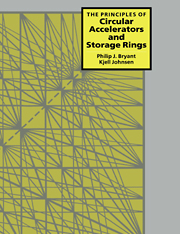Book contents
- Frontmatter
- Contents
- Foreword
- Coordinate system
- Symbols
- Useful Constants
- 1 Introduction
- 2 Basic concepts and constant-gradient focusing
- 3 Alternating-gradient focusing
- 4 Parameterisation of the transverse motion
- 5 Imperfections and resonances
- 6 Chromaticity
- 7 Longitudinal beam dynamics
- 8 Image and space-charge forces (transverse)
- 9 Coherent instabilities
- 10 Radiating particles
- 11 Diagnosis and compensation
- 12 Special aspects of circular colliders
- Appendix A Transverse particle motion in an accelerator
- Appendix B Accelerator magnets
- Appendix C Closed orbits
- Appendix D Phase equation
- Appendix E Vlasov equation
- References
- Index
11 - Diagnosis and compensation
Published online by Cambridge University Press: 11 November 2009
- Frontmatter
- Contents
- Foreword
- Coordinate system
- Symbols
- Useful Constants
- 1 Introduction
- 2 Basic concepts and constant-gradient focusing
- 3 Alternating-gradient focusing
- 4 Parameterisation of the transverse motion
- 5 Imperfections and resonances
- 6 Chromaticity
- 7 Longitudinal beam dynamics
- 8 Image and space-charge forces (transverse)
- 9 Coherent instabilities
- 10 Radiating particles
- 11 Diagnosis and compensation
- 12 Special aspects of circular colliders
- Appendix A Transverse particle motion in an accelerator
- Appendix B Accelerator magnets
- Appendix C Closed orbits
- Appendix D Phase equation
- Appendix E Vlasov equation
- References
- Index
Summary
There is much truth in the statement that a machine is only as good as its diagnostic equipment, but paradoxically it often happens that this is the first area to feel the cold draught of budget cuts. The careful preparation of algorithms for controlling machine parameters and plentiful instrumentation saves time and avoids the random chance of trial-and-error adjustments. Time spent in observation and understanding is always well spent and leads to future improvements in performance.
When commissioning an accelerator ring the first problem is to get a circulating beam. Apart from the jubilant press release announcing the first injection (of importance for funding agencies) little can be done until the beam makes at least a full circuit of the machine. This is primarily a problem of the closed orbit. The first step is taken during the machine design when a prognosis is made of the expected closed-orbit distortion, which is then used to set tolerances. Later algorithms are developed for measuring and correcting the orbit under various conditions as well as some tools for diagnosing the errors to guide the survey team. Orbit measurements can also be used for checking many optics parameters. Next on the list is the tune of the machine. The tune can be deduced from orbit measurements by noting the beam positions on four consecutive passages, but unless the beam is being lost after a few turns, it is more convenient and accurate to apply other techniques.
- Type
- Chapter
- Information
- The Principles of Circular Accelerators and Storage Rings , pp. 252 - 284Publisher: Cambridge University PressPrint publication year: 1993



